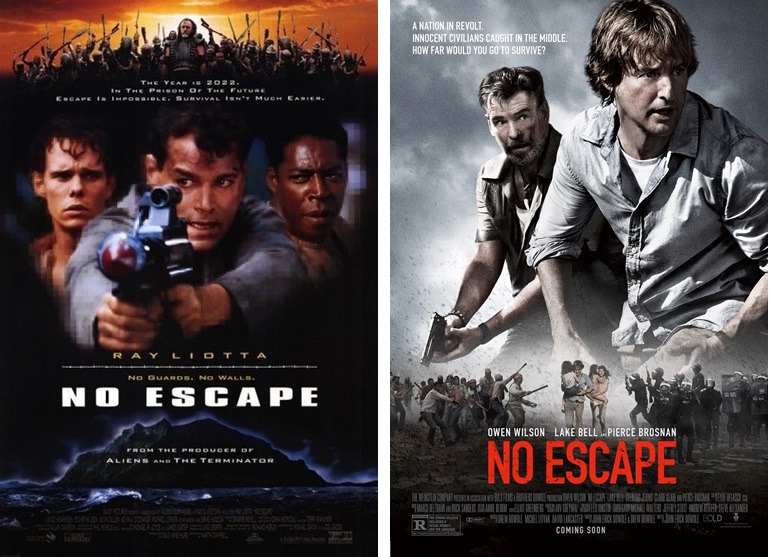In terms of new releases, late August is always the cinematic doldrums. Studios are now savvier about how they parse late summer releases—“Guardians of the Galaxy” came out in August last year, and this year titles like “American Ultra” and “Hitman: Agent 47” have the potential to become sleeper hits in the wake of records set by “Straight Outta Compton“—yet the month before Labor Day is traditionally a last summer hurrah, not a chance to see another blockbuster. Besides, most critics now turn their attention to The Toronto Film Festival, which is an early harbinger of the year’s remaining prestige releases. This August is no different from summers past, yet one title caught my attention. “No Escape” looks like another middling thriller where an everyman must make difficult, sudden decisions in order to protect his family. Something about the title nagged at me, and I couldn’t quite put my finger on it until days later: there’s already a movie called “No Escape,” and I’ve seen it.
Released in April 1994, the science-fiction thriller “No Escape” drifted away from our collective cultural memory. Its trailer has less than seven thousand views on YouTube, and the packaging on its Amazon page recalls the first wave of DVD in the late 1990s. Given the film’s pedigree and box office performance, however, it’s ironic “No Escape” amounts to little more than a memory. It stars Ray Liotta, a commanding actor who had no trouble with leading roles in the wake of “GoodFellas.” The film was directed by Martin Campbell, who went on to direct “Goldeneye,” “The Mask of Zorro” and “Casino Royale,” which veer from pretty damn good to downright superb. More importantly, “No Escape” was number one at the box office the weekend it opened. How could a movie with such talent, for all intents and purposes, be forgotten? Maybe the 1994 “No Escape” deserves status as a cult classic? In any event, revisiting the movie would be an opportunity, albeit an arbitrary one, to see just how action films changed over the past twenty years.
Finding a copy of “No Escape” was not as cheap as I had hoped. It is not available on any VOD platforms, so I could either buy it from Amazon Prime for a price typically associated with a Criterion release ($25), or wait a week and get a less expensive copy from eBay. At a barbecue this summer, I mentioned this dilemma to Ramin, my good friend and neighbor, and as luck would have it he had a copy. I should have known Ramin would own this title: he hosts semi-regular movie nights where he invites a group of people to watch a campy action flick from the late eighties and nineties (past titles include “Road House,” “Shakedown” and “Demolition Man”). Before each screening, Ramin gives a brief presentation about the movie, and afterward there’s a thirty-question multiple choice quiz over the move’s minutiae. We watched “Hackers” at Ramin’s last movie night, for example, and there was heated debate over the question, “How many nipples appear in total?” In other words, he would be the perfect “No Escape” companion.
Before the opening credits finished, something was already abundantly wrong. The DVD of “No Escape” is so old that it’s a VHS transfer, and its “letterbox” formatting was meant for a cathode ray television with a 4:3 ratio. It took a few minutes of tinkering before we arrived at a zoom that took up most of the flat screen without distorting the image, yet the problems did not stop there. The premise of “No Escape” is profoundly silly. Set in 2022, Liotta stars as John Robbins, a disgraced soldier who’s serving a life sentence in a high tech maximum security prison. The warden (Michael Lerner) is sick of Robbins’ numerous escape attempts, so he decides to send him to an anonymous tropical island where the most dangerous criminals can live the rest of their days. There he discovers two warring factions, led by the evil Marek (Stuart Wilson) and the enigmatic man known as The Father (Lance Hendriksen). Robbins is not much of a joiner, yet finds himself at the frontline for the inevitable big battle.
The most striking difference about “No Escape” and more modern action films is how Campbell and his team make full use of the sets they designed. Without access to CGI and teams of animators, Campbell relied on more practical effects, which meant he would reconfigure the same dirty, unimaginative set several times in order to maximize the producers’ investment. The two island bases in “No Escape” recall Steven Spielberg’s notion of Neverland in “Hook,” but much more violent. There are primitive traps throughout the island, and each death is met with a gruesome close-up, an overwrought one-liner, or both. Although the action is never quite thrilling, there is something to be said about Campbell’s reliance on extras and stunt men. The broad, old-fashioned canvas of hundreds of real moving bodies still has an appeal, which is partially why a recent spectacle like “Mad Max: Fury Road” captures the imagination while CGI-heavy fare often does not. Modern action directors can let their imaginations run wild, so there are fewer inventions through necessity.
The dated production values may have some novelty, but the stupidity of the premise nearly renders “No Escape” unwatchable. There is never an adequate reason why the Warden wants to keep the hardened prisoners on an island. How is their survival profitable? To what end does it serve? A simple throwaway line about human experiments or whatever would suffice, yet Robbins and the other island “inmates” are left to their own devices, and indeed have more self-determination than most any other prisoners on Earth. There is a scene midway through the film where Robbins stands on a beach and gazes into the sunset, aching for escape from his picaresque island hell. I could not help but think of “The Shawshank Redemption,” another film about prison life, that ends with a similar image, only it represents absolute freedom. The idiocy does not end there: the Warden decides to solve the island squabbling by paying a personal visit there, despite the fact that several armed warplanes are stationed nearby. Indeed, “No Escape” is the sole screenwriting credit for Michael Gaylin, and that’s because his stadium-sized plot holes betray the movie’s title.
After an ending that lands like a bad “Twilight Zone” episode, a feeling of genuine relief accompanies the end credits. “No Escape” is an exhausting movie, one that would be borderline fun if it treated the audience with any intelligence. In the subsequent discussion, I asked Ramin why he doesn’t show “No Escape” for one of his movie nights, and he said, “It is way, way too bad for that.” Even for a guy who delights in the low-effort thrills of adequate action filmmaking, “No Escape” is not worthy of a social event that’s based on mockery, not appreciation. If anything, this experience should be a lesson to those who are curious about many old movies: if a distant memory and a crappy DVD is all we have of an old movie, there is usually a good reason why. The August 26th release date of 2015’s “No Escape” means it may suffer the same slow, inglorious death of the 1994 edition, yet the newfound ease of online viewing comes with a benefit we sometimes take for granted. Nowadays it’s much simpler to dismiss mediocrity outright, instead of merely forgetting it.












